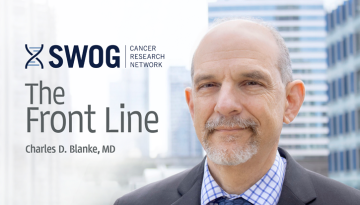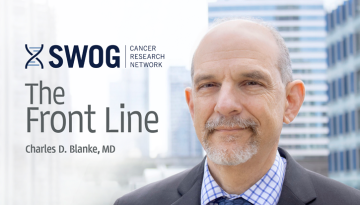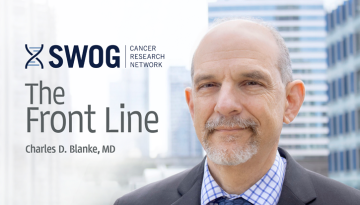Broad Engagement Makes for Better Trials
TrACER is unique on a few fronts.
It’s a SWOG Cancer Research Network trial funded not only by NCORP, but also by the Patient-Centered Outcomes Research Institute (PCORI). It is also the first cluster-randomized trial we’ve managed, and one of our first pragmatic studies.
TrACER, or S1415CD, comes out of SWOG’s cancer care delivery committee. It’s led by Dr. Scott Ramsey from the Hutchinson Institute for Cancer Outcomes Research (HICOR). TrACER is short for Trial Assessing Colony Stimulating Factor Prescribing, Effectiveness, and Risk and it tests the effectiveness of a systems-based intervention to increase guideline-adherent use of colony stimulating factors (CSF). We already knew physicians don’t always follow prescribing guidelines for these drugs; In fact, they both under- and over-prescribe them. Dr. Ramsey and the TrACER team want to know if a guideline-based standing order for administering CSF improves adherence and reduces the incidence of febrile neutropenia.
Despite a steep enrollment goal (3,600 eligible patients) and a modicum of logistical hurdles, TrACER is sailing smoothly so far. The trial enrolled over 800 patients in its first year and 3,564 to date – putting it on target to close as planned in March 2020.
The secret to its success? Broad and meaningful stakeholder engagement, done in a unique way.
TrACER includes a 21-member external stakeholder advisory group, including four physicians, two pharmacists, two payers, two guideline experts, and one medical ethicist. The group also includes 10 patient advocates, including several from SWOG. In a recent publication in BMC Medical Research Methodology, the TrACER team explains the impact of the advisory group:
“Effective stakeholder engagement in the design, conduct, and reporting of clinical research is essential to project success, particularly in cancer care delivery research,” it concludes. “Different perspectives can lead to improved patient-centric design and facilitate implementation of a trial.”
Dr. Gary Lyman, SWOG executive officer and senior lead for health care quality and policy at HICOR, puts it this way: “When you have different eyes on your trial, it gets better. Everyone sees different challenges and opportunities based on their experience. Our advisors have been great.”
The BMC article notes stakeholders improved TrACER through:
- Better design: Help in adjusting trial endpoints, arms, risk levels, and patient surveys
- Better implementation: Help in developing a plain language patient brochure and study summary and, given the high cost of CSF, a compilation of financial resources for patients
- Better enrollment: Increasing connection with patients, including advice to approach them during chemotherapy teaching sessions and messaging about the trial advancing quality care
- Better dissemination: Help in writing the BMC article and present poster abstracts, as well as raising trial awareness on social media and with non-profit advocacy groups
Ari Bell-Brown, TrACER project manager, presented the study to our recruitment and retention committee in Chicago. Here’s what she said about the external stakeholder advisory group:
“They made the study as patient-centered as possible. They worked with us on the protocol, consent, recruitment documents, surveys, and recruitment strategies to help collect the best data for researchers and make the trial as easy as possible for participants. As we move forward into dissemination, they’re working with us to ensure that results get to the population that this study truly impacts, including patients that participated.”
And here’s her advice to you: “Engage early! It’s great to have some stakeholder involvement during the research development and proposal phase. And budget for stakeholder engagement even if your study isn’t PCORI funded. They are a critical voice for our study.”
Lots to learn from this important trial!
Other Recent Stories



